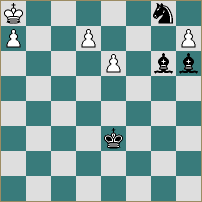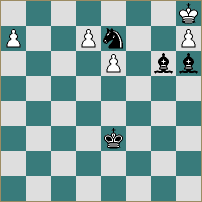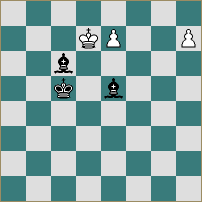Endgame Dialogue
 The above position arose in a friendly game down at the club and sparked off a fascinating analysis. It is Black to play; the question is: can White draw? I was merely a spectator; the three main protagonists were Professor Peter Pimpleton, Major Basil Beerbelly (the club champion) and Barbarella, a talented young lady from France. As I recall, the dialogue unfolded something like as follows:
Professor Pimpleton: ‘How can Black stop all these pawns? Oh, I say! There’s a brilliant way to force the king all the way across the eighth rank - look!’ and he flashed out the following moves:
1... Be4+
The above position arose in a friendly game down at the club and sparked off a fascinating analysis. It is Black to play; the question is: can White draw? I was merely a spectator; the three main protagonists were Professor Peter Pimpleton, Major Basil Beerbelly (the club champion) and Barbarella, a talented young lady from France. As I recall, the dialogue unfolded something like as follows:
Professor Pimpleton: ‘How can Black stop all these pawns? Oh, I say! There’s a brilliant way to force the king all the way across the eighth rank - look!’ and he flashed out the following moves:
1... Be4+
2.Kb8 Bf4+
3.Kc8 Ne7+
4.Kd8 Nc6+
5.Ke8
Major Beerbelly: ‘Very nice! Do you mind if I call you a genius?’
Professor Pimpleton: ‘Not at all, go right ahead.’
At this point Barbarella chipped in: ‘Yes, I also see what you are up to, but what if I don’t oblige and try to draw by going the other way? After 5.Kc8(?) Nxa7+ 6.Kd8 Nc6+ 7.Kc8, I don’t see what you can do.’
Major Beerbelly: ‘There is a win; I can just take the pawn:7...Bxh7! and if 8.d8Q Nxd8 9.e7 Bf5+ (9...Nf7? 10.e8Q+) 10.Kxd8 Bg5 11.Ke8 Be6 12.Kf8 Bh6+ 13.Ke8 Ke4 and you can’t stop my king approaching. 14.Kd8 Bg5 15.Ke8 Ke5. Convinced?’
They all agreed it was very clear and Professor Pimpleton continued demonstrating his sequence, of which he was obviously very proud.
5... Bg6+
6.Kf8 Bh6+
7.Kg8 Ne7+
Professor Pimpleton: ‘All the black minor pieces 'switchback'. Compare the start position with the position after White’s next - the black pieces have more or less stayed where they were and the white king has crossed the eighth rank from corner to corner. Amazing!’
Barbarella: ‘Not really; it happens all the time. I’m always getting my king chased across the board.’
8.Kh8
 ‘What now?’ asked Barbarella ‘I suppose Black is just lost now, after that little escapade.’
Major Beerbelly: ‘No! Black has another shot. I can force your d-pawn to knight, so that it can’t queen!’
‘The Holst theme’ pointed out Professor Pimpleton to everybody’s bewilderment.
8... Bf5!
‘What now?’ asked Barbarella ‘I suppose Black is just lost now, after that little escapade.’
Major Beerbelly: ‘No! Black has another shot. I can force your d-pawn to knight, so that it can’t queen!’
‘The Holst theme’ pointed out Professor Pimpleton to everybody’s bewilderment.
8... Bf5!
9.d8N!
‘ See, it’s mate in two after 9.d8Q? Ng6+ 10.Kg8 Bxe6#. Now I can stop Alfred the a-pawn too.’ Major Beerbelly added.
9... Be4
Professor Pimpleton: ‘Prophylaxis on every conceivable occasion!’
Barbarella: (not getting the joke) ‘Maybe White can get a draw by just waiting?’
Professor Pimpleton: ‘No you can’t! Black can just advance his king.’
10.Nf7!
Major Beerbelly: ‘The only move since the king is locked in and 10.Nc6? Bxc6 11.a8Q Ng6+! spoils the stalemate trap (11...Bxa8?=). After 12.Kg8 Bxa8 13.Kf7 Nh8+! (13...Be4? 14.e7 Nxe7 15.h8Q) 14.Kg8 (14.Kf6 Bc6-+) 14...Bd5 15.Kxh8 Bf4 (15...Bxe6?=) 16.Kg7 Be5+ 17.Kf7 White is a crucial tempo too slow:
17...Kf4 18.Ke7 Kf5 and Black wins.’
10... Bf8
Professor Pimpleton: ‘That must be best, too, because if 10...Bf4? 11.Kg7 is no problem for White. It’s clear that it’s White who’s struggling to draw now.’
At this point there was a long analysis session, since it seemed the knight could try several squares. Eventually, with the help of a computer, the truth was found:
11.Nd6!
The only move to draw. At first there was a mutual misunderstanding, everybody thought that the other knight moves were also drawn:
11.Nd8? [11.Ne5? Bd5 12.a8=Q Bxa8 13.Nc6 transposes. White cannot wait since Black threatens to utilise his king] 11...Bd5 12.a8Q The stalemate trap again, which must be played in the right order (12.Nc6? Ng6+ 13.Kg8 Bxe6#) 12...Bxa8 13.Nc6 Ng6+! (13...Nxc6 14.Kg8; 13...Bxc6?=) 14.Kg8 Bxc6 This time the bishop is on f8 rather than h6, which helps White. However, Black still wins, as the following lines demonstrate:
A) 15.Kf7 Be4 16.h8Q Nxh8+ 17.Kxf8 At first they all thought this was a draw, but Major Beerbelly found 17...Ng6+ 18.Ke8 (18.Kf7 Nf4! 19.e7 Bg6+ 20.Kf8 Ne6+ wins) 18...Bc6+ 19.Kd8 Nf4 20.Kc7 (20.e7 Ne6+) 20...Ba4 21.Kd6 Nh5 with a blockade
B) 15.h8Q 15...Nxh8 16.Kxf8 Ng6+ 17.Kg7 Ne7 18.Kf7 Nf5 and again, Black wins easily.
11... Ng6+!
‘I’m going to have your knight as well! Then I must be winning.’ opined Barbarella. ‘Not necessarily, but it’s certainly an assessment within half a point of being correct!’ replied Major Beerbelly, by far the strongest player at the club.
‘She’s always had great gift of the grab, but we can come back to that later; first we should look at 11...Bd5’ insisted Professor Pimpleton, the most systematic of our three friends.
‘I see a brilliant move! After 12.a8Q! (12.Nc8? Ng6+ 13.Kg8 Bxe6#) 12...Bxa8 (12...Ng6+ 13.Kg8 Bxe6+? 14.Nf7) White has 13.Nc8!!’ exclaimed Major Beerbelly, explaining that 13.Nf5+? Nxf5 14.Kg8 Bg7 15.e7 Bd5# was no good, and that after 13...Ng6+ (13...Bd5 14.Nxe7 Bxe6 15.Ng6 Bh6 16.Ne5 Ke4 17.Nf7 is a draw, as is 13...Nxc8 14.Kg8) 14.Kg8 Bc5 (14...Bd5 15.Kf7=) 15.h8Q Nxh8 16.Kxh8 Black cannot stop the white king supporting his pawn, with a draw.
Barbarella: ‘All very clever, but don’t my three extra pieces win after 11...Ng6+, as I suggested earlier?’
Professor Pimpleton: ‘Let’s see, it doesn’t look all that clear to me.’
12.Kg8 Bxd6
13.Kf7!
‘13.h8Q? Nxh8 14.Kxh8 Kf4 15.Kg7 Ke5 16.Kf7 Bd5 17.a8Q Bxa8 18.e7 Bd5+ wins.’ Major Beerbelly pointed out.
13... Be5
Barbarella thought 13...Nh8+ wins, since 14.Kg8 Be5 15.e7 Bd5+! 16.Kf8 Ng6+ 17.Ke8 Nxe7 is positionally winning. White is helpless and Black can bring up his king and eat the pawns one by one. Also 14.Ke8 Be5 15.e7 Ng6 16.Kf7 Nxe7 17.Kxe7 Bd5 reaches the same position. Major Beerbelly, however, found:
14.Kf6! Kd4 (14...Ng6 15.a8Q Be5+ 16.Kf7 Bxa8 17.Kxg6 transposes to 13...Be5.) 15.e7 when Black should be careful. There are two lines:
A) 15...Be5+? forces White to find some accurate moves, but after 16.Ke6 (16.Kg5? Nf7+ 17.Kg4 Nd6-+) 16...Bd5+ 17.Kd7! (17.Kf5? Nf7 18.e8Q Nd6+) 17...Kc5 18.e8Q Bc6+ 19.Ke7 Bd6+ 20.Kd8, it is clear that it is Black who has real problems.
B) 15...Bxe7+ 16.Kxe7 draws. Formally the line ends here, but Professor Pimpleton who, having read ‘Secrets of Spectacular Chess’, was quick to notice such amusing features, pointed out that after 16...Ke5 17.Kd7 (17.Kf8 is also a draw) 17...Kf6 18.Kc7 Kg7 19.Kb8 Kxh7 20.a8Q Bxa8 21.Kxa8, the white king has ended up back in its original corner!
14.a8Q! Bxa8
15.Kxg6 Bc6
Barbarella: ‘What about 15...Be4+?’
Professor Pimpleton: ‘It comes to the same thing, since it transposes’
Major Beerbelly: ‘That’s a tautology, but you’re right both times!’.
16.Kf7!
Major Beerbelly demonstrated that White is helpless after 16.e7? Be8+!.
16... Bd5
Professor Pimpleton: ‘Now White has to go in front of his own pawn. Strange the way the king is heading back to the queenside.’
Major Beerbelly: ‘White might still be in trouble, you know; Black can use his king, too.’
17.Ke7! Kd4
18.Kd7 Kc5
19.e7 Bc6+
 20.Ke6!
Professor Pimpleton: ‘Fantastic! It gains a critical tempo against the unprotected bishop on e5, preventing 20...Be8. The white king switches direction yet again.’
Major Beerbelly: ‘There’s another trap:
20.Ke6!
Professor Pimpleton: ‘Fantastic! It gains a critical tempo against the unprotected bishop on e5, preventing 20...Be8. The white king switches direction yet again.’
Major Beerbelly: ‘There’s another trap:
20.Kd8? Kd6 21.e8N+ Ke6 is possible, leading to the lost N vs 2B ending. After your 20.Ke6 it’s a clear draw - the bishop moves and we play 21.Kf7.’
Barbarella: ‘If my logic is right, White has had to find a whole series of only moves. How many have there been?’
Professor Pimpleton: (who was writing down the analysis) ‘White has played nineteen only moves in a row! Twenty after 20...Bc3 (say) 21.Kf7.’
Major Beerbelly: ‘Actually 21.h8=Q also draws, so it’s only nineteen. A fair number were not just ‘only’ moves, but ‘only legal’ ones.’
Barbarella: ‘Still, it was quite a tightrope that White had to walk. I’ve never seen so many false trails.’
Major Beerbelly: ‘It’s true... you didn’t see very many of them.’
Barbarella: ‘Thank you very much! If only you had a bit of humility, you’d be just perfect.’
So what happened in the game? I suppose I’ll have to admit it. I lied. As you probably realised ages ago, the position was not actually from a real game. I spent a rather sad Christmas making it all up. Yes, you have been looking at an endgame study. There are two stages: the introduction, where the king is forced across the eighth rank (geometry and flow are the aesthetic elements here) and the difficult, trap infested second phase, where you have to see a great deal (for both sides) to find the right moves (with some depth and paradox involved this time). The study ends after 20.Ke6.
Back to other articles
Top of this page
Main page
Back to the3 studies page


